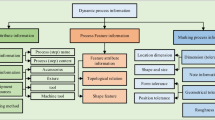Abstract
Milling using a sequence of tools has become very attractive with the advent of rapid tool change mechanisms in modern CNC machines. However, the commercial CAM systems used to generate G&M code rely on experienced process planners to select a good tool sequence. When a tool sequence is selected and tool paths are generated, NC-verify systems are used to check the tool paths for tool holder collisions. If tool holder collisions are detected, the part has to be re-planned ab-initio. In this paper, we describe a method to select an optimal tool sequence by formulating the problem under certain assumptions as the shortest path solution to a single source directed acyclic graph. Also described is a method to incorporate tool holder solution in the context of selecting an optimal tool sequence. Examples have been worked out to illustrate the workings of the algorithm.
Similar content being viewed by others
References
S. Arya S.W. Cheng D.M. Mount (2001) ArticleTitleApproximate algorithm for multiple-tool milling International Journal of Computational Geometry and Applications 11 IssueID3 339–372
M. Bala T.C. Chang (1991) ArticleTitleAutomatic cutter selection and cutter path generation for prismatic parts International Journal of Production Research 29 IssueID11 2163–2176
Y. Chen Y.S. Lee S.C. Fang (1998) ArticleTitleOptimal cutter selection and machining plane determination for process planning Journal of Manufacturing Systems 17 IssueID5 371–388
T. Cormen C. Leiserson R. Rivest (1997) Introduction to Algorithms McGraw Hill New York
R. D’Souza P.K. Wright C.H. Séquin (2001) ArticleTitleAutomated microplanning for 2.5D pocket machining Journal of Manufacturing Systems 20 IssueID4 288–296
Echave, J., Shah, J.J. (1999). Automatic setup and fixture planning for 3-Axis milling. In ASME Design Automation Conference on Las Vegas, NV
S. Gao J.J. Shah (1998) ArticleTitleAutomatic recognition of interacting machining features based on minimal condition subgraph Computer Aided Design 30 IssueID9 695–705 Occurrence Handle10.1016/S0010-4485(98)00033-5
J. Joo H. Cho (1999) ArticleTitleEfficient sculptured pocket machining using feature extraction and conversion Journal of Manufacturing Systems 18 IssueID2 100–112
B. Kannan P.K. Wright (2001) ArticleTitleEfficient algorithms for automated process planning for 2.5D machined parts considering fixturing constraints International Journal of Computer Integrated Manufacturing 17 IssueID1 16–28
L. Kunwoo T.J. Kim S.E. Hong (1994) ArticleTitleGeneration of toolpath with selection og proper tools for rough cutting Computer Aided Design 26 IssueID11 63–180
T. Lim J. Corney J.M. Ritchie D.E.R. Clark (2000) ArticleTitleOptimizing automatic tool selection for 2.5D and 3D NC surface machining Computers in Industry 26 IssueID1 41–59
Y.S. Lee T.C. Chang (1995) ArticleTitleApplication of computational geometry in optimization of 2.5D and 3D NC surface machining Computers in Industry 26 IssueID1 41–59 Occurrence Handle10.1016/0166-3615(95)80005-0
MASTERCAM (2002). http://www.mastercam.com
Regli, W. (1995). Geomteric Algorithms for Recognition of Features from Solid Models. PhD Thesis, University of Maryland at College Park
SURFCAM (2002). http://www.surfcam.com
D. Veeramani Y.S. Gau (1997) ArticleTitleSelection of an optimal set of cutting tool sizes for 2.5D pocket machining Computer Aided Design 29 IssueID12 869–877 Occurrence Handle10.1016/S0010-4485(97)00042-0
Z. Yao S.K. Gupta D.S. Nau (2001) ArticleTitleA geometric algorithm for finding the largest milling cutter SME Journal of Manufacturing Processes 3 IssueID1 1–16
Author information
Authors and Affiliations
Corresponding author
Additional information
Received: February 2005 / Accepted: September 2005
Rights and permissions
About this article
Cite this article
D’Souza, R.M. Selecting an Optimal Tool Sequence for 2.5D Pocket Machining while Considering Tool Holder Collisions. J Intell Manuf 17, 363–372 (2006). https://doi.org/10.1007/s10845-005-0009-6
Issue Date:
DOI: https://doi.org/10.1007/s10845-005-0009-6




